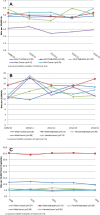Epidemiologic comparison of ankle injuries presenting to US emergency departments versus high school and collegiate athletic training settings
- PMID: 30175385
- PMCID: PMC6119677
- DOI: 10.1186/s40621-018-0163-x
Epidemiologic comparison of ankle injuries presenting to US emergency departments versus high school and collegiate athletic training settings
Abstract
Background: Ankle sprains account for a large proportion of injuries presenting to both United States (US) emergency departments (EDs) as well as high school (HS) and collegiate school athletic training settings. The epidemiologic differences across these settings by both sport and diagnosis have not been well differentiated. Ankle injury data from 3 national surveillance datasets. Athletic training setting data from the National High School Sports-Related Injury Surveillance System and the National Collegiate Athletic Association Injury Surveillance Program was from academic years 2009/10 through 2013/14 and the US Consumer Product Safety Commission's National Electronic Injury Surveillance System (ED setting) data was from calendar years 2009 through 2013. Data was analyzed for patients 14-22 years old participating in 12 sports (male football, baseball, basketball, lacrosse, soccer, and wrestling, and female softball, basketball, lacrosse, soccer, volleyball, and field hockey). We calculated sport-specific injury rates, proportions, and rate ratios (RRs) with 95% confidence intervals (CI).
Results: During the study period, the surveillance systems captured 20,261 ankle injuries presenting to EDs plus 5546 HS and 2725 collegiate injuries presenting to school athletic training settings. Rates were higher in collegiate compared to HS athletes presenting in the athletic training setting. Football accounted for the largest proportion of ankle injuries presenting to HS (31.2%) and college (41.0%) athletic training settings; male basketball accounted for the largest proportion presenting to EDs among both HS (41.0%) and college (65.8%) aged patients. Sprains/strains accounted for over 80% of injuries in all three settings. Fractures accounted for a larger proportion of ankle injuries presenting to EDs (9.5%) compared to HS (3.8%) and college (0.8%) athletic training settings. There was no change in injury rates during the study period across the three settings.
Conclusions: Injury rates and patterns varied by sport and presentation setting, with athletic trainers evaluating more ankle injuries overall in the collegiate setting compared to the high school setting. Ankle injuries presenting to EDs were more commonly fractures, suggesting that more severe injuries present to this setting. Understanding the epidemiology of such patterns will help readers interpret differences in publications reporting data from varied clinical settings.
Keywords: Ankle; Collegiate athletes; Emergency department; Injury surveillance; Pediatrics; Sports.
Conflict of interest statement
Ethics approval and consent to participate
The institutional review board of Nationwide Children’s Hospital and the Research Review Board of the NCAA approved the study. Individual athlete consent to participate is not acquired in the three national surveillance systems which supplied data for this study.
Consent for publication
Not applicable
Competing interests
The authors declare that they have no competing interests.
Publisher’s Note
Springer Nature remains neutral with regard to jurisdictional claims in published maps and institutional affiliations.
Figures


Similar articles
-
Epidemiologic comparisons of soccer-related injuries presenting to emergency departments and reported within high school and collegiate settings.Inj Epidemiol. 2017 Dec;4(1):19. doi: 10.1186/s40621-017-0116-9. Epub 2017 Jul 3. Inj Epidemiol. 2017. PMID: 28670666 Free PMC article.
-
Descriptive Epidemiology of Non-Time-Loss Injuries in Collegiate and High School Student-Athletes.J Athl Train. 2017 May;52(5):446-456. doi: 10.4085/1062-6050-52.2.15. Epub 2017 Mar 30. J Athl Train. 2017. PMID: 28358221 Free PMC article.
-
Epidemiologic comparison of injured high school basketball athletes reporting to emergency departments and the athletic training setting.J Athl Train. 2014 May-Jun;49(3):381-8. doi: 10.4085/1062-6050-49.3.09. Epub 2014 Apr 23. J Athl Train. 2014. PMID: 24758246 Free PMC article.
-
A Sport-specific Analysis of the Epidemiology of Hip Injuries in National Collegiate Athletic Association Athletes From 2009 to 2014.Arthroscopy. 2019 Sep;35(9):2724-2732. doi: 10.1016/j.arthro.2019.03.044. Arthroscopy. 2019. PMID: 31500761
-
Epidemiology of Common Injuries in the Volleyball Athlete.Curr Rev Musculoskelet Med. 2023 Jun;16(6):229-234. doi: 10.1007/s12178-023-09826-2. Epub 2023 Apr 4. Curr Rev Musculoskelet Med. 2023. PMID: 37014607 Free PMC article. Review.
Cited by
-
Intrinsic Risk Factors for Ankle Sprain Differ Between Male and Female Athletes: A Systematic Review and Meta-Analysis.Sports Med Open. 2022 Nov 18;8(1):139. doi: 10.1186/s40798-022-00530-y. Sports Med Open. 2022. PMID: 36399159 Free PMC article.
-
Epidemiology of ∗Upper Extremity Lacrosse Injuries presenting to the United States Emergency Departments during 2014-2023.J Hand Microsurg. 2025 May 12;17(4):100281. doi: 10.1016/j.jham.2025.100281. eCollection 2025 Jul. J Hand Microsurg. 2025. PMID: 40491756 No abstract available.
-
Diagnostic Imaging for Distal Extremity Injuries in Direct Access Physical Therapy: An Observational Study.Int J Sports Phys Ther. 2023 Apr 2;18(2):431-438. doi: 10.26603/001c.73314. eCollection 2023. Int J Sports Phys Ther. 2023. PMID: 37020437 Free PMC article.
-
Differences in health-related quality of life among patients after ankle injury.Front Sports Act Living. 2022 Aug 3;4:909921. doi: 10.3389/fspor.2022.909921. eCollection 2022. Front Sports Act Living. 2022. PMID: 35992155 Free PMC article.
-
Does Neuromuscular Electrical Stimulation Improve Recovery Following Acute Ankle Sprain? A Pilot Randomised Controlled Trial.Clin Med Insights Arthritis Musculoskelet Disord. 2019 May 20;12:1179544119849024. doi: 10.1177/1179544119849024. eCollection 2019. Clin Med Insights Arthritis Musculoskelet Disord. 2019. PMID: 31205428 Free PMC article.
References
Grants and funding
LinkOut - more resources
Full Text Sources
Other Literature Sources
Medical

